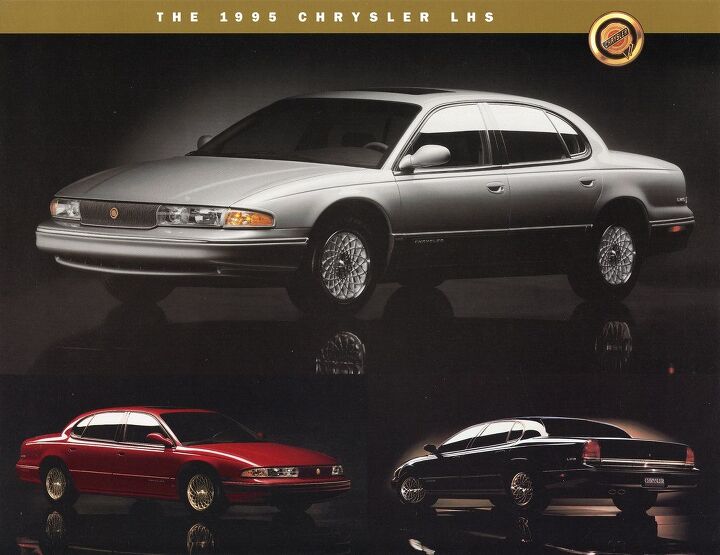Rare Rides: A Stunning Chrysler LHS From 1995, Fine Executive Luxury

Today’s Rare Ride was commonplace a couple of decades ago, but it’s one of those cars by and large ruined via neglectful owners, inattentive build quality from the factory, and BHPH lots.
Come along as we learn about the most luxurious Chrysler LH sedan of the Nineties.
This isn’t the first time we’ve featured an LH car in this series, as that honor goes to the extra clean Eagle Vision presented last year. But while the Vision appealed more to the sporty sedan customer with its no-nonsense alloys and monochromatic exterior theme, today’s LHS was all about luxury motoring.
At its debut in 1994, the LHS was Chrysler’s flagship sedan. LHS stood as a direct replacement for the K-car based (or super XL EEK-LX whatever) Imperial, which resurrected the Imperial name at Chrysler in 1990. That model deserves its own Rare Rides entry and was pretty outdated and bad even at introduction.
Chrysler sought to make amends for that with the cab-forward LHS, which was bang up to date. Chrysler also offered two lesser luxury versions of the LH at its dealers, the middle sibling New Yorker, and the cheapest Concorde. The Concorde LH replaced the K-car New Yorker in ’94, and the New Yorker LH took over for the Fifth Avenue K. The LHS and New Yorker shared identical styling, while the Concorde was more Intrepid-adjacent in its looks. Part of that was down to the additional length for New Yorker and LHS: They both had five inches of full-size stretch over Concorde.
The LHS was differentiated from its slightly lesser New Yorker brother (red above) primarily via exterior badging and lack of chrome trim. Inside, LHS customers were treated to leather bucket seats instead of a bench, and standard lace alloy wheels which were optional at the New Yorker level. The LHS always had its shift lever on the floor, and the interior was generally of a higher specification than New Yorker.
While the Concorde was available with either 3.3- or 3.5-liter engines, New Yorker and LHS were all equipped with the 3.5. That EGE engine was good for 214 horses and 221 lb-ft of torque. A four-speed automatic was the only transmission option.
The LHS proved more popular than the New Yorker as bench seats, chrome trim, and column shifters clung to their Eighties customer base. New Yorker was dropped after 1996, and instead, the LHS gained a bench seat option. LHS continued on sale in its initial guise through 1997 and was replaced by the new 300M-adjacent LHS in 1999. LHS lived only through 2001 before it was axed. Chrysler carried on with the Concorde through 2004, before it and the 300M were replaced by the rear-drive 300.
Today’s Rare Ride is located at an auction house in North Carolina. In suitably luxurious white and silver over tan, it has over 150,000 miles yet shockingly looks brand new. It’s the cleanest example your author has seen, ever.
[Images: Chrysler]

Interested in lots of cars and their various historical contexts. Started writing articles for TTAC in late 2016, when my first posts were QOTDs. From there I started a few new series like Rare Rides, Buy/Drive/Burn, Abandoned History, and most recently Rare Rides Icons. Operating from a home base in Cincinnati, Ohio, a relative auto journalist dead zone. Many of my articles are prompted by something I'll see on social media that sparks my interest and causes me to research. Finding articles and information from the early days of the internet and beyond that covers the little details lost to time: trim packages, color and wheel choices, interior fabrics. Beyond those, I'm fascinated by automotive industry experiments, both failures and successes. Lately I've taken an interest in AI, and generating "what if" type images for car models long dead. Reincarnating a modern Toyota Paseo, Lincoln Mark IX, or Isuzu Trooper through a text prompt is fun. Fun to post them on Twitter too, and watch people overreact. To that end, the social media I use most is Twitter, @CoreyLewis86. I also contribute pieces for Forbes Wheels and Forbes Home.
More by Corey Lewis
Latest Car Reviews
Read moreLatest Product Reviews
Read moreRecent Comments
- Ras815 Jeep reliability is trash and FCA is a nightmare, but I've got to give credit where credit is due: the Wrangler color palette is consistently one of the best in the industry.
- Tassos Jeep has always been about FREEDOM and freedom to EXPRESS YOURSELF. I, REAL Tassos, LOVE this for the brand it’s buyers. I have ordered one already with a matching blue lives matter American flag sticker.
- Bd2 In the case of a company like Stellanis and their reputation, perhaps they would have better luck with External Combustion.
- Honda1 Only a brain dead moron would do this!
- Master Baiter Ditch the Giga-casting and Robo-taxi. I'd rather have a turn signal stalk.





































Comments
Join the conversation
Note the rather casual fit of all that plastic lower cladding...if you go to the auction website you will find a 1981 Cordoba for sale in what is considered excellent condition. Go through the photos and see the abysmal fit and detail work...wow. I forgot how bad it was back then. So, scratch my negative comment about the LHS. It's a Rolls Royce in comparison.
At the time this flagship was created, Chrysler was in "Build Back Better But Still Not All That Great" mode.